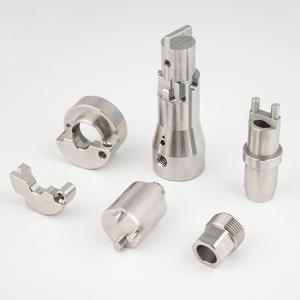
Add to Cart
Professional Manufacturer OEM ODM CNC Processing Service Turning CNC Parts
Metal Machined Part Lathe CNC Machining Part
How does custom CNC machining service work?
Custom CNC machining is a widely adopted subtractive manufacturing technology renowned
for its excellence in crafting bespoke metal and plastic components tailored for both prototyping
and production needs.
By harnessing CAD (computer-aided design) modeling software in conjunction with G-code,
CNC milling and CNC turning machines proficiently remove material from solid workpieces with
exceptional precision and speed.
CNC machines are adept at producing durable parts characterized by stringent tolerances
and a diverse range of outstanding material properties, both mechanical and chemical in nature.
Our bespoke CNC machining service is ideally suited for singular projects and medium-volume
production runs, capitalizing on automation and a high degree of reproducibility.
Product Details
Here is a comprehensive overview of the most popular materials
| The Most Popular Materials | |
| Material | Characteristics |
| Aluminum 6061 | Good strength-to-weight ratio, excellent machinability, low hardness |
| Stainless Steel 304 | Excellent mechanical properties, resistant to corrosion & acid, relatively difficult to machine |
| Brass C360 | High ductility, excellent machinability, good corrosion resistance |
| ABS | Excellent impact resistance, good mechanical properties, susceptible to solvents |
| Nylon (PA6 & PA66) | Excellent mechanical properties, high toughness, poor moisture resistance |
| POM (Delrin) | High stiffness, excellent thermal & electrical properties, relatively brittle |




| Surface Finishes | ||
| Name | Applicable to | Machining marks |
| As machined | Metals, Plastics | Visible, light surface scratches |
| Smooth machining | ||
| Fine machining | Metals | Slightly visible |
| Polishing | Metals | Removed on primary surfaces |
| Bead blasting | Metals | Removed for non-cosmetic, removed on primary surfaces for cosmetic |
| Brushing | Metals | |
| Anodizing Type II | Aluminum | |
| Anodizing Type III | Aluminum | Visible under anodizing |
| Black oxide | Copper, Stainless steel, Alloy steel, Tool steel, Mild steel | Visible |
| Powder coating | Metals | Removed |
| Brushed + electropolishing | Stainless steel | Removed on Primary surfaces |
Specialist Industries
We’ve manufactured millions of parts for all sorts of applications,
but we’re especially knowledgeable in these areas.
1. Aerospace & aviation
2. Automotive
3. Industrial machinery
4. Consumer electronics
5. Robotics & automation
6. Medical

Company Profile


FAQ's
1. What tolerance standards do you guarantee?
We assure that our factory adheres to ISO 2768 standards for all CNC machined parts.
For parts machined with metals, we strictly follow ISO 2768-m (medium) or ISO 2768-f (fine) standards.
In the case of parts machined with plastics, we comply with 2768-m (medium) standards.
While geometric tolerances as tight as ± 0.0004 inches (0.010 mm) are attainable, it is imperative
that they are clearly specified in the technical drawings.
We can achieve even finer tolerances on shafts, with up to H7 fits, through manual quoting and,
on occasion, even tighter ones.
2. What's the best application of CNC machining?
CNC machining finds its sweet spot in single-job manufacturing and low-to-medium volume production,
typically ranging from several hundred to 1,000 parts.
It shines as the go-to choice for crafting metal prototypes, offering exceptional cost-efficiency.
Furthermore, CNC machining stands out when your parts demand exceptionally precise tolerances.
3. What's the general surface texture of CNC milled and turned parts?
In the realm of CNC machining, as-machined milled parts typically exhibit a surface roughness of
approximately 3.2μm (or 1.6μm in the case of relatively new machines). On the other hand,
when it comes to turned parts, we can achieve a smoother surface with a roughness of 0.8μm.
This means that machining speed adjustments are not necessary to attain this level of surface finish.
4. How do you speed up CNC manufacturing?
The pace of manufacturing in CNC machining is influenced by various factors, encompassing part
design and the desired surface finish. One illustrative approach to expedite the machining process
is by incorporating fillets instead of sharp corners in your design.
This design adjustment allows for the use of standard tools throughout production, eliminating
the need for tool changes during machining and thereby enhancing manufacturing speed.